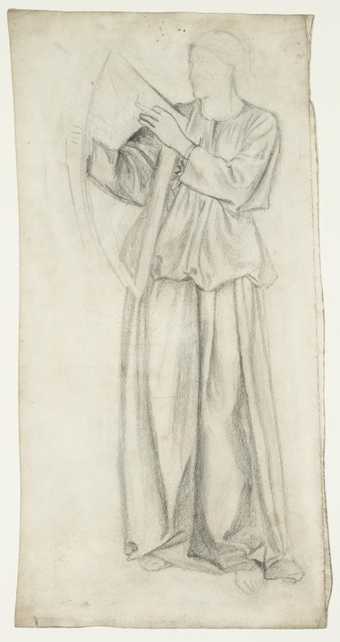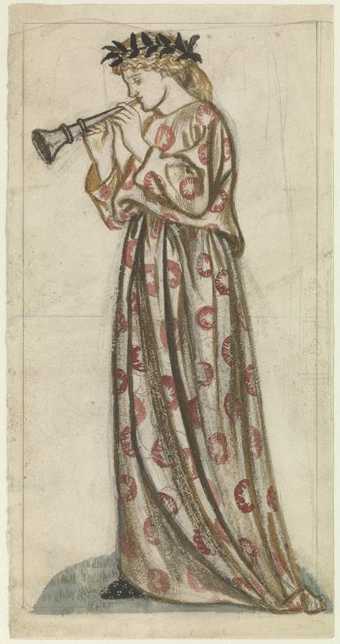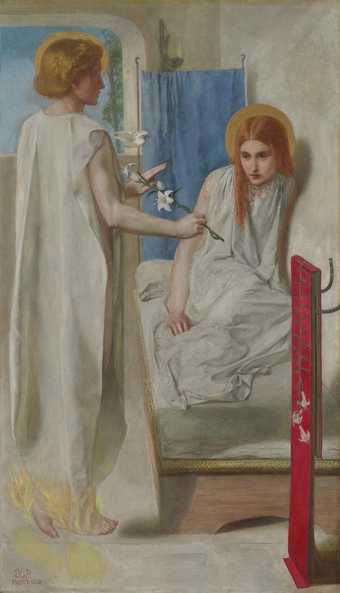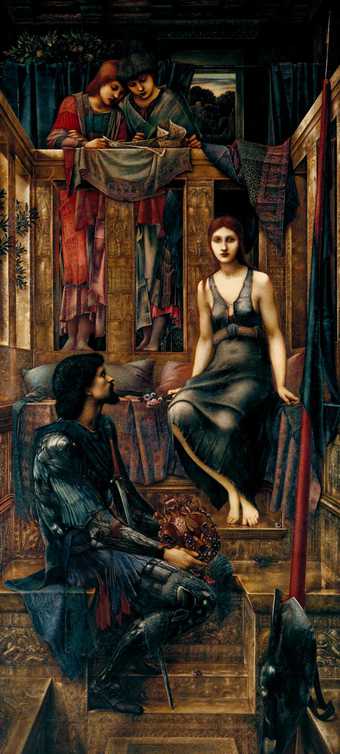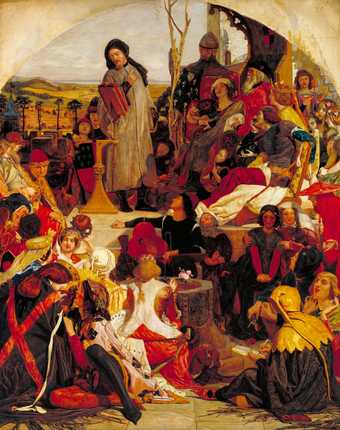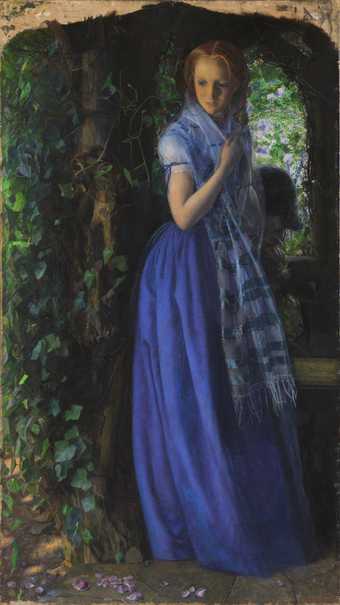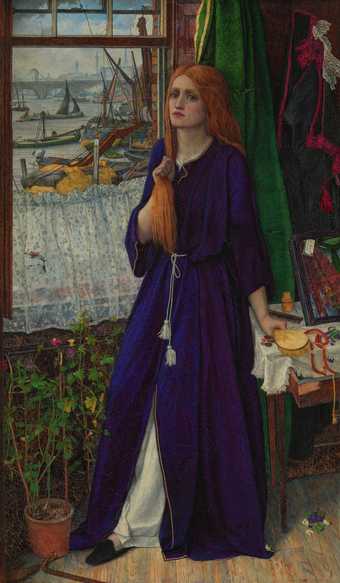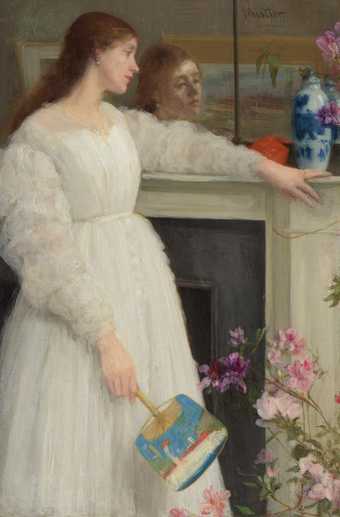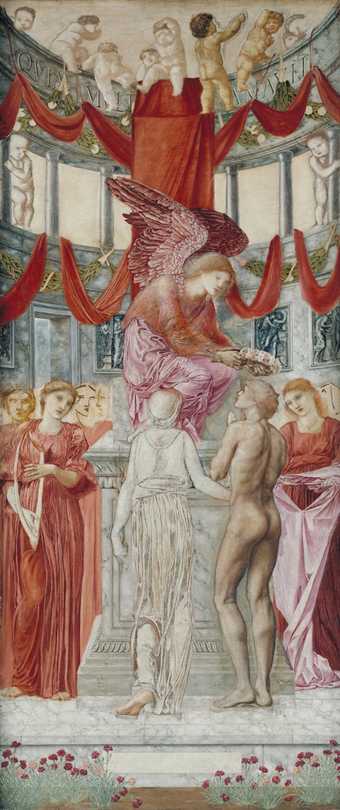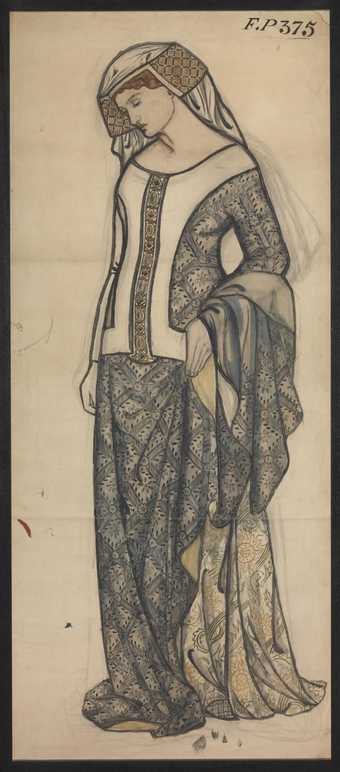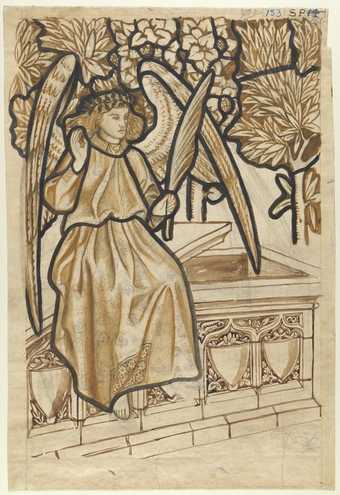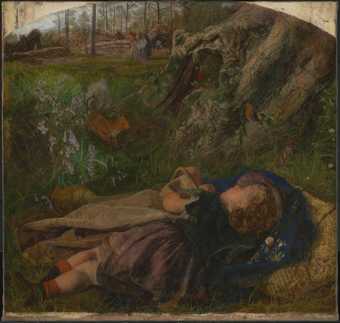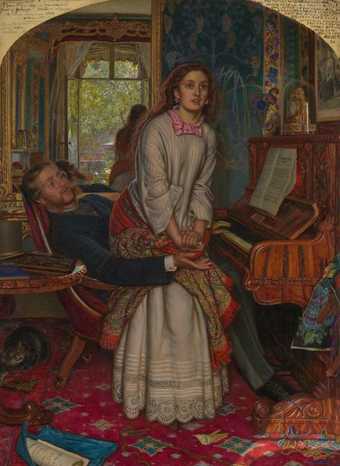
On loan
Tullie House Museum and Art Gallery Trust (Carlisle, UK): The Legend of King Arthur: A Pre-Raphaelite Love Story
- Artist
- William Morris 1834–1896
- Medium
- Oil paint on canvas
- Dimensions
- Support: 718 × 502 mm
frame: 960 × 755 × 61 mm - Collection
- Tate
- Acquisition
- Bequeathed by Miss May Morris 1939
- Reference
- N04999
Summary
This is the only completed easel painting that William Morris produced. It is a portrait in medieval dress of Jane Burden, whom Morris married in April 1859. The picture has been identified in the past as Queen Guenevere, partly owing to the fact that Morris published his first volume of poetry, The Defence of Guenevere, in March 1858. However, recent research has established convincingly that the picture is intended to represent Iseult mourning Tristram's exile from the court of King Mark.
Iseult appears to have recently arisen from her bed, where a small greyhound lies curled up among the crumpled sheets. In Le Morte d'Arthur (c.1470), the author, Sir Thomas Malory (c.1405-71), reminds us that 'the queen had always a little brachet [bitch-hound] with her that Sir Tristram gave her the first time that ever she came into Cornwall, and never would that brachet depart from her but if Sir Tristram was nigh' (quoted in Banham and Harris, p.115). She stands wistfully in her small chamber, her feelings for Tristram reinforced by the sprigs of rosemary, symbolising remembrance, in her crown, and the word 'DOLOURS' (grief) written down the side of her mirror.
The rich colours, the emphasis on pattern and details such as the illuminated missal reveal where Morris's true talents lay. He was less at home with figure painting than with illumination, embroidery and woodcarving, and he struggled for months on this picture. He worked for much of the time at 17 Red Lion Square, the rooms he shared with Edward Burne-Jones. Many of the furnishings such as the Turkish rug, Persian embroidered cover and whitework hangings on the bed were probably in Morris's personal collection. The background panel is close in style to the heavy tapestries designed by Morris for Red Lion Square and the table cover is of the type taken as a model by Morris and Webb for the firm's church furnishings.
In 1874 the picture was claimed as his own by Ford Madox Brown's son Oliver. Rossetti, who had a great fondness for Jane Burden, offered him £20 for it as 'an early portrait of its original, of whom I have made so many studies myself' (quoted in Parry, p.103). The picture eventually passed to Rossetti's brother, William Michael. It lay forgotten in a cupboard until Rossetti's death, when it was returned to Jane Burden.
Further reading:
Joanna Banham and Jennifer Harris (eds), William Morris and the Middle Ages, exhibition catalogue, Whitworth Art Gallery, Manchester 1984, pp.114-6, reproduced pl.IV, in colour.
Leslie Parris (ed.), The Pre-Raphaelites, exhibition catalogue, Tate Gallery, London 1984, reprinted 1994, pp.169-70; reproduced p.169.
Linda Parry (ed.), William Morris, exhibition catalogue, Victoria & Albert Museum, London 1996, pp.102-3, reproduced p.89, in colour.
Frances Fowle
December 2000
Does this text contain inaccurate information or language that you feel we should improve or change? We would like to hear from you.
Display caption
The inspiration for this painting was Thomas Malory's 'Morte d'Arthur' (1485), in which Guinevere's adulterous love for Sir Lancelot is one of the central themes. The model is Jane Burden who became Morris's wife in 1859, and also appears in Rossetti's 'Proserpine' displayed nearby. She was 'discovered' by Morris and Rossetti when they were working together on the Oxford Union murals, the subject matter for which was also taken from Malory. The painting is essentially a portrait of her in medieval dress. It is a splendid expresion of the intense medieval style prevailing in Rossetti's circle in the late 1850s, with its emphasis on pattern and historical detail. This is Morris's only completed oil painting.
Gallery label, September 2004
Does this text contain inaccurate information or language that you feel we should improve or change? We would like to hear from you.
Explore
- emotions, concepts and ideas(16,416)
-
- emotions and human qualities(5,345)
-
- contemplation(141)
- politics and society(2,337)
- music and entertainment(2,331)
-
- music(916)
- clothing and personal items(5,879)
-
- dress(381)
- fruit, orange(28)
- book - non-specific(1,954)
- crown(88)
- actions: postures and motions(9,111)
-
- standing(3,106)
- woman(9,110)
- Burden, Jane(2)
- Morris, Jane(4)
- individuals: female(1,698)
- arts and entertainment(7,210)
-
- musician(789)
- queen(245)
You might like
-
William Morris An Angel with a Harp
date not known -
William Morris A Girl with a Flute
date not known -
Attributed to William Morris The Archangel Raphael
date not known -
Dante Gabriel Rossetti Ecce Ancilla Domini! (The Annunciation)
1849–50 -
Sir Edward Coley Burne-Jones, Bt King Cophetua and the Beggar Maid
1884 -
Ford Madox Brown Chaucer at the Court of Edward III
1856–68 -
Arthur Hughes April Love
1855–6 -
John Roddam Spencer Stanhope Thoughts of the Past
exhibited 1859 -
James Abbott McNeill Whistler Symphony in White, No. 2: The Little White Girl
1864 -
Sir Edward Coley Burne-Jones, Bt The Temple of Love
date not known -
William Morris Figure of Guinevere
c.1858 -
William Morris Guinevere and Iseult: Cartoon for Stained Glass
1862 -
William Morris Angel of the Resurrection: Cartoon for Stained Glass
1862 -
Arthur Hughes The Woodman’s Child
1860 -
William Holman Hunt The Awakening Conscience
1853

